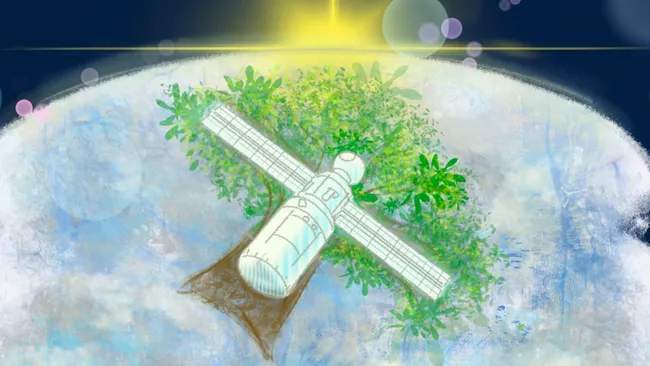World’s First Picket Satellite tv for pc Launched for Area Sturdiness Testing – The Unconventional Gardener
Header picture: An idea drawing of a satellite tv for pc lined in wooden and leaves. Picture credit score: KyotoU World Comms/Jake Tobiyama.
People have relied on forests and bushes – for shelter, meals, and gas -from the earliest instances. As expertise has superior, timber has been used for buildings, ships, and railroads. And now we could also be on the verge of taking wooden into area.
Why wooden? Constructing in area with futuristic, ‘space-age’ supplies would possibly appear to be the plain selection: lumber’s fragility and combustibility might sound counter-intuitive by comparability.
Therein lies the rationale for wooden: as a pure, economical, carbon-based materials, its manufacturing is significantly extra sustainable than superior alternate options, and its disposal – particularly when dropped from orbit into the higher ambiance – is full and with out dangerous byproducts.
Furthermore, investigations in Earth-bound labs have demonstrated wooden’s stunning means to resist a variety of temperatures, from -150 to 150 levels Celsius. Simulated near-vacuum circumstances additionally resulted in negligible structural deterioration of the wooden.
However the subsequent step is to transcend: to truly take wooden into area.
“Wooden’s means to resist simulated low earth orbit – or LEO – circumstances astounded us.
We now need to see if we are able to precisely estimate the consequences of the tough LEO atmosphere on natural supplies.”
Koji Murata, head of the space-wood analysis effort and member of the Biomaterials Design Lab at Kyoto College’s graduate faculty of agriculture

wooden samples despatched to Worldwide Area Station for testing. Picture credit score: Kyoto College
The LignoSat Area Wooden Undertaking
The LignoSat Area Wooden Undertaking (AKA “LignoStella”) started in April 2020, as a collaboration between Koji Murata’s crew on the College of Kyoto, company associate Sumitomo Forestry and Japanese area company JAXA. In 2022, they despatched a collection of picket samples from varied plant species to the uncovered experiment platform of the Kibo module on the Worldwide Area Station.
JAXA astronaut Koichi Wakata retrieved the wooden panel, which returned to Earth aboard SpaceX’s CRS-26 cargo Dragon spacecraft in January 2023 for detailed evaluation.
“We significantly need to measure the diploma of abrasion ensuing from atomic oxygen collisions with the fibrous materials,” Murata mentioned, referring to the truth that LEO is characterised by the presence of free oxygen atoms touring at excessive velocity, which over time may cause harm to uncovered surfaces.
We additionally need to see the consequences of cosmic rays and the vacuum of area on the mechanical properties of wooden.”
The analysis group performed a preliminary inspection involving energy assessments and elemental and crystal structural analyses. The experiment outcomes confirmed minimal deterioration and good stability of the samples chosen for the picket synthetic satellite tv for pc LignoSat2.
Regardless of the acute atmosphere of outer area involving vital temperature modifications and publicity to intense cosmic rays and harmful photo voltaic particles for ten months (240 days), assessments confirmed no decomposition or deformations, comparable to cracking, warping, peeling, or floor harm.
The analysis group has decided that LignoSat2, scheduled to be collectively launched in 2024 by NASA and JAXA, will seemingly use the Magnolia wooden – or Hoonoki in Japanese – for its ultimate properties. The crew selected Magnolia‘s comparatively excessive workability, dimensional stability, and total energy.
LignoSat launch

LignoSat has simply launched to the Worldwide Area Station on SpaceX resupply mission CRS-31, and will likely be launched to outer area in a couple of month to check its energy and sturdiness.
All sides of the box-like experimental satellite tv for pc measures simply 10 centimeters (4 inches).
Information will likely be despatched from the satellite tv for pc to researchers who can test for indicators of pressure and decide if the satellite tv for pc can face up to excessive modifications in temperature.
“Satellites that aren’t manufactured from metallic ought to grow to be mainstream,” Takao Doi, an astronaut and particular professor at Kyoto College, mentioned at a press convention earlier this yr.
References:
KyotoU to check slats of wooden aboard Japan’s Kibo platform on the ISS, August 2021.
Sampling for sustainability in outer area, January 2024
World’s first picket satellite tv for pc launched into area, November 2024
Except in any other case acknowledged, © Copyright Emma Doughty 2024. Revealed on theunconventionalgardener.com.
If you happen to loved this publish, please contemplate supporting my work. I’ve a subscriber-only Patreon for area plant lovers, or you could possibly simply purchase me a cup of tea:
Many thanks!



















